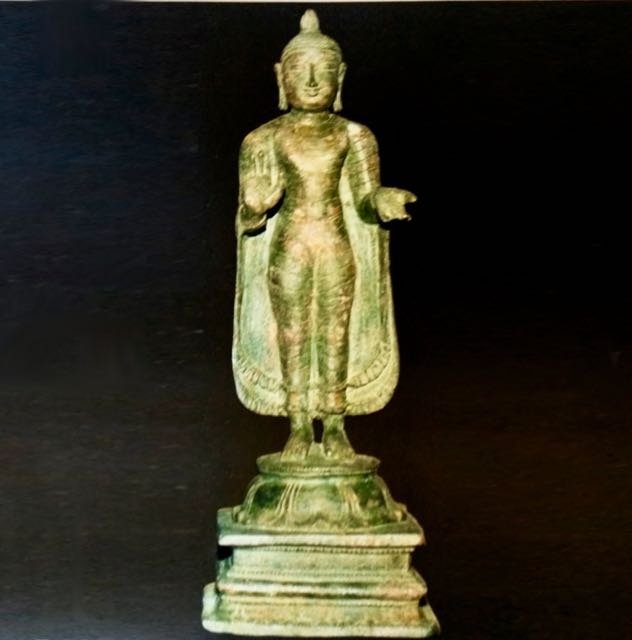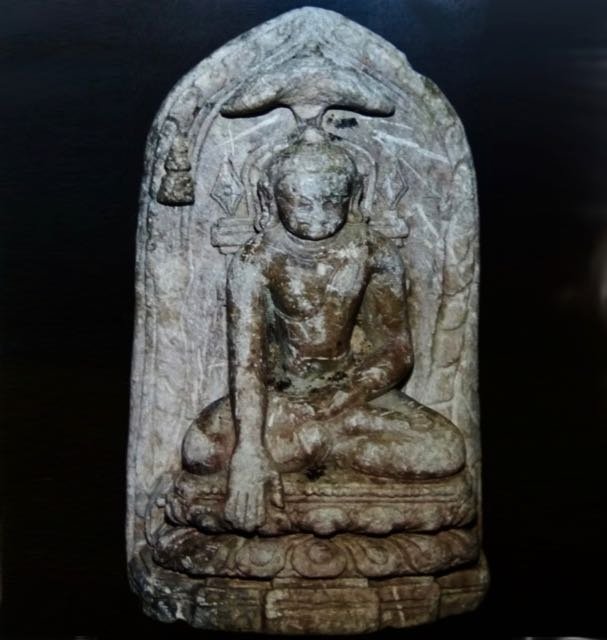Ancient Buddhist statues unearthed in Sellur, Tamil Nadu
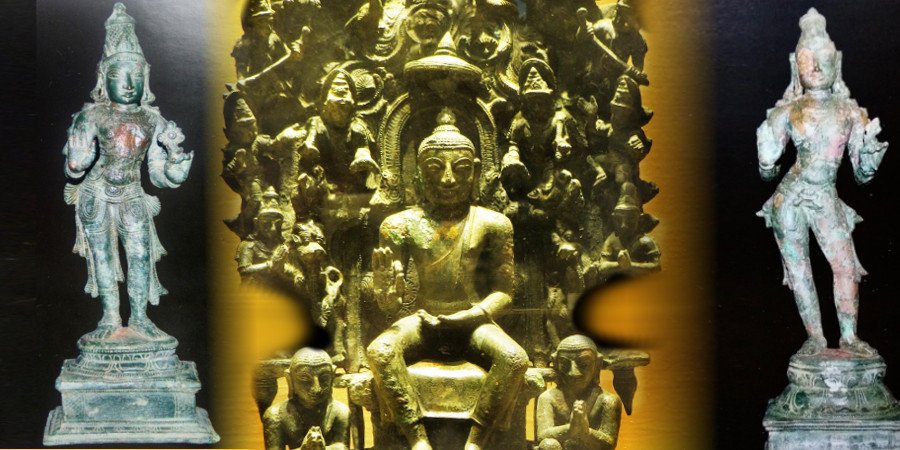
Statues and Stupas from Sellur in Later Chola Period
In 2004, T. Ramalingam, a farmer in Sellur (Kodavasal Taluk, Thiruvarur dist. Tamil Nadu), was digging his property to lay foundations for his house. To his amazement, he came across a great treasure trove of Buddhist artifacts underneath the soil. There were 42 pieces of ancient Buddhist bronze statues and three stone and marble statues that reveal many facts about a flourishing period of Buddhism in Thiruvarur during the later Chola period (11-13th Century CE) (Ref-A). The farmer handed over these statues to Chennai Museum.
The accidental discovery of this collection in the recent past indicates that significant chapters of the Buddhist history of Tamil Nadu could still be waiting to be discovered. This is especially so since not much excavation and research has happened on this post-independence.
Thiruvarur district is adjacent to Nagapattinam, the last citadel of Buddhism in South India. In this post, we shall discuss some of the important statues and stupas from Sellur, Regarding the Sellur collection, we could see a handful of these statues and stupas in the gallery of Buddhist and Jain bronzes in Chennai Museum that usually remains closed. The remaining are said to be in the reserve. We rely on the information from Ref-A
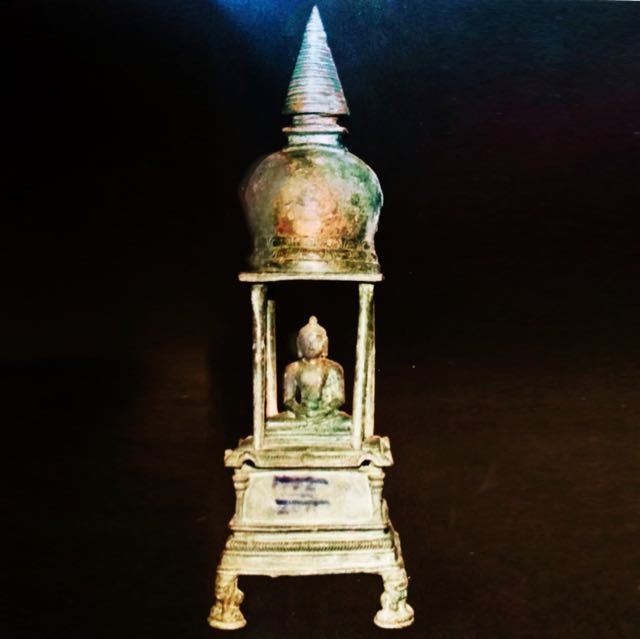
The most special among the Sellur collection are (i) an elaborately casted Buddha seated in bhadra-asana (with legs down) with celestial and human disciples around, (ii) a reliquary stupa that condenses the meaning of the eight stupas associated with Buddha into one (the eight corresponds to eight major events in the life of the Buddha) and (iii) another stupa above a Buddha seated on lion’s throne. One of the remarkable features of many Buddha statues of Sellur is that they have one hand in karana-mudra (the gesture of warding off obstacles and negativities), similar to Nagapattinam statues. Sellur statues of Buddha, Avalokitesvara and Maitreya can be seen to be belonging to the same style and school as Nagapattinam statues.
Buddha Statues from Sellur
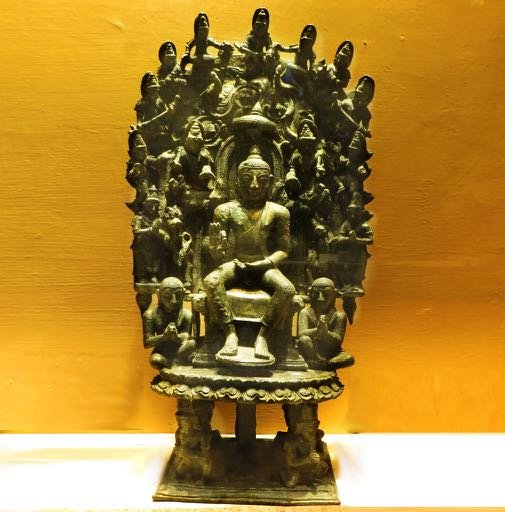
This statue has some very intricate carvings with Mahayana-style details. The Buddha is seated on a throne in the backdrop of a bodhi-tree. The throne is supported by four celestial beings. There is a chathra (royal umbrella) above his head. In the outer circle around him are devas holding a variety of musical instruments like lute, cymbals, mridanga, etc. In the inner circle are some human disciples as well as two celestial beings (devas) holding a chamara (fly-whisk) and a scripture each. This is presently in the Buddhist and Jain Bronze Gallery of Chennai Museum. According to archeologists, this statue is from the 11th Century CE. (Photo by authors)
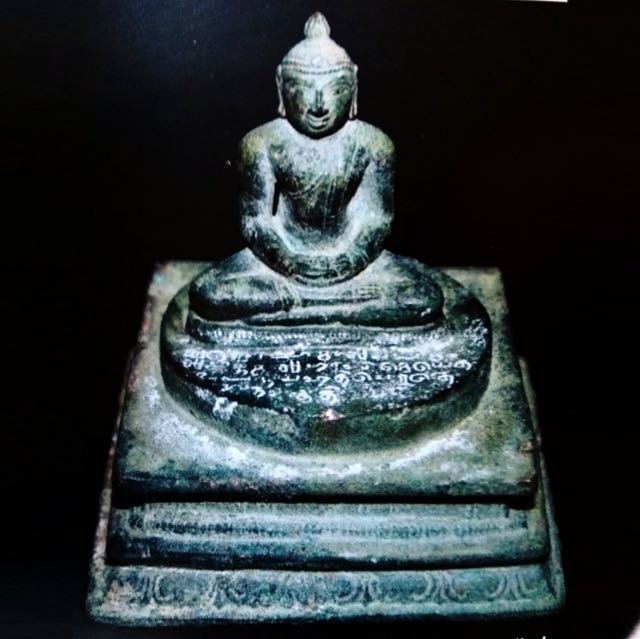
This Buddha statue (4.5 inches) is supposed to be in Chennai Museum (probably in reserve). A verse from Dhammapada is inscribed on it in Tamil letters. The words are in Pali, making it clear that not only Mahayana, but the Shravakayana traditions also coexisted in this area. The inscriptions are at the round pedestal on which the Buddha is seated. The round-pedestal itself is over a square lotus seat. According to archeologists, this is from the 13th Century CE. The verse translates into,
“He abused me, he beat me, he defeated me, he robbed me of my property. Whosoever harbor such thoughts will never be able to pacify their hatred.”
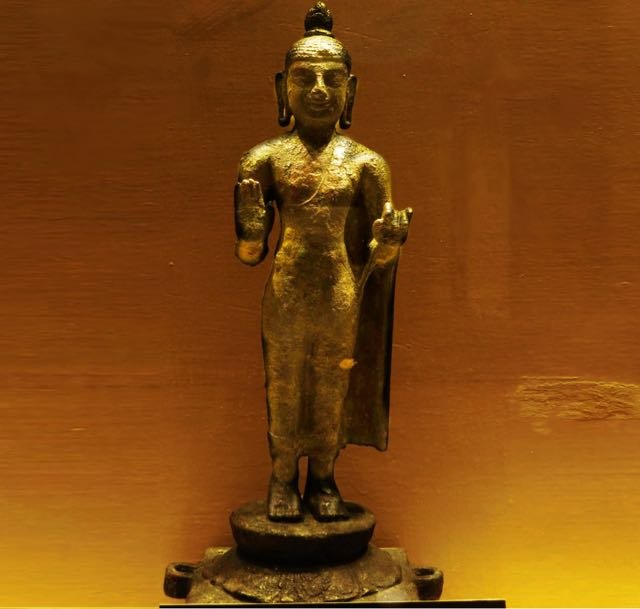
Standing Buddha Statue ‘C’ above is now kept in the Buddhist and Jain Bronze Gallery of Chennai Museum. The Buddha’s right hand is in abhaya mudra (gesture of protection) and the left hand is in karana-mudra (gesture of warding off obstacles and negativities). This is a unique aspect of many Nagapattinam-style Buddha statues. The pair of rings on the pedestal indicates that this statue would have been used for the annual procession through the city (bum-khor). According to archeologists, this is from the 12th Century CE.
Standing Buddha Statue ‘D; and ‘E’ are not in the gallery. In ‘D’, the Buddha has his left hand in ahuya-vara (gesture of inviting and granting). This is from the 13th Century CE. The statue ‘E is from the 12 Century CE.
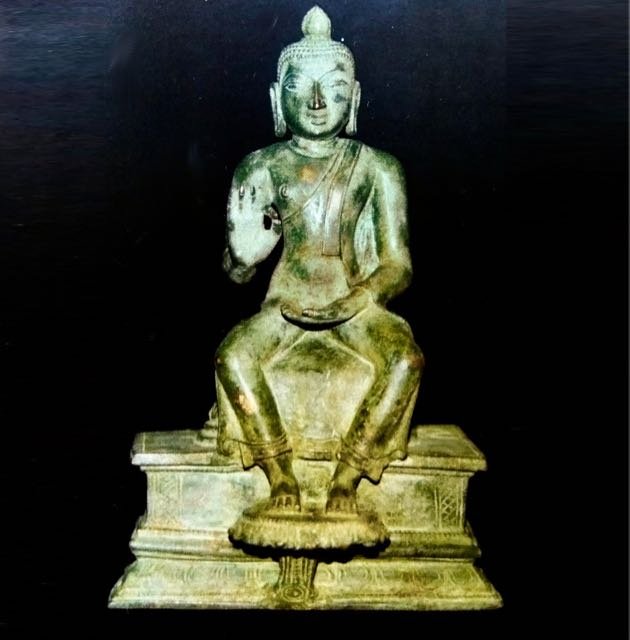
In ‘F’, Buddha is seated in bhadra-asana with feet resting on a lotus pistil. This posture is typical for Maitreya, but have been used in the iconography of the Buddha also sometimes. The right-hand shows tri-ratna mudra (gesture of showing triple jewels) and the left hand is in dhyana-mudra (gesture of meditation).
Both G and H are probably in the reserve. In ‘G’, the Buddha is in bhumi-sparsha mudra (gesture of earth-touching), unlike most other Tamil Nadu Buddhas that are in dhyana-mudra (gesture of earth-touching).
‘I’ and ‘J’ are miniature sized statues and are probably in reserve. ‘J’ is made of palnad marble stone, unlike most other Sellur artifacts that are in bronze. (This material is widely used for Amaravati buddha statues). There is chathra (umbrella) on the top and a stupa on the top right.
A Delicate Stupa from Sellur
A Reliquary stupa is part of the 45 statues and stupas unearthed in Sellur, Thiruvarur, Tamil Nadu. This is now kept in the Buddhist and Jain Bronze Gallery at Chennai Museum. Archeologists estimate this to be a work of 11th Century CE (Chola period). This stupa has a total height of 16 inches and would have originally contained some precious relics.
The remarkable aspect of this stupa is that it has eight carvings depicting the eight major events in the life of the Buddha. These eight also corresponds to the eight great stupas (mahachaityas) at Lumbini, Bodhgaya, Saranath, Sankashya, Vaisali, Rajgir, Shavasti and Kushinagara. Typically, in Mahayana Buddhism, these eight great stupas are depicted using their own unique shapes to represent these eight events. Here in Sellur, the eight stupas (མཆོད་རྟེན་ཆ་བརྒྱད་) are combined into a single stupa using individual illustrations of these eight events. We shall explain in another post about these eight aspects.
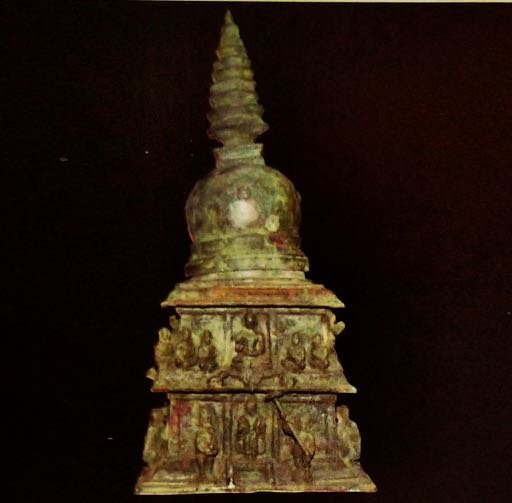
The upper depiction on this side (Side 1, Picture K) is about the first turning of the wheel of Dharma at the deer-park in Saranath. Buddha is seated with the right-hand tri-ratna mudra (gesture of triple jewels), indicating teaching. He is seated on a throne with the marking of Dharmachakra and two deers on its side. Five disciples can be seen on the side with anjali-mudra (gesture of folded hands paying homage).
The lower depiction on this side is about the descent of the Buddha from Tushita at arriving at Sankashya. The Buddha is standing with the right-hand in abhaya-mudra (gesture of protection) and the left-hand in varada-mudra (gesture of granting). There are stairs in the backdrop to indicate the descent from Tushita. Two devas flank the Buddha on both sides.
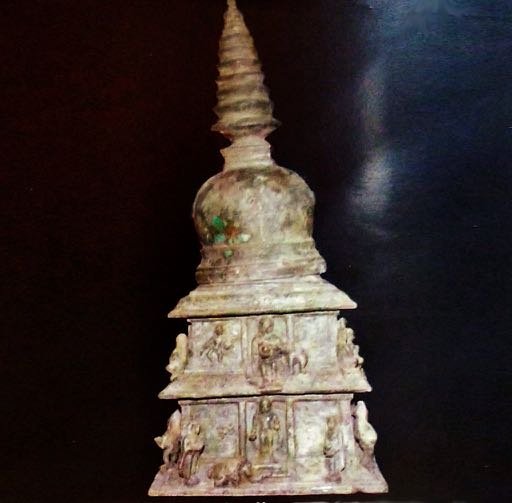
The upper depiction on this side (Side 2, Picture L) is about an elephant and monkey offering food to the Buddha at a forest in Vaishali. Buddha is seated in bhadra-asana (with legs down). An elephant is seen making offerings to him, and there is a monkey on his right side. This represents the time when there were two quarreling factions within the sangha and the Buddha decided to go alone to the forest. At that time an elephant attended to the Buddha by bringing fruits every day. Seeing the elephant making offerings to the Buddha, a monkey too made an offering.
The lower depiction on this side is about the Buddha taming Nalagiri, the mad elephant at Rajagriha (Rajgir). An elephant can be seen kneeling before the Buddha with his trunk at the Buddha’s feet. There is one bhikshu with anjali-mudra on one side and another holding, possibly, a begging bowl. This incident happened when Devadatta, the Buddha’s cousin was jealous about the Buddha and schemed to kill him by letting free a mad elephant to go on Buddha’s way and attack him. However, the elephant became peaceful upon approaching the Buddha and he simply kneeled down before the Buddha.

The upper depiction of this side (SIde 3, Picture M) is about the parinirvana of the Buddha. The Buddha is seen lying down with the right hand under the head. Two bhikshus are seated with anjali-mudra. This represents the Buddha lying down between two Sala trees at the time of his parinirvana (final passing away) at Kushinagara.
The lower depiction is about the birth of the Buddha. Queen Mayadevi is standing and taking support on the shoulder of an attendant. The baby Siddhartha is shown on the right side. This corresponds to the birth of the Buddha at the grove in Lumbini.
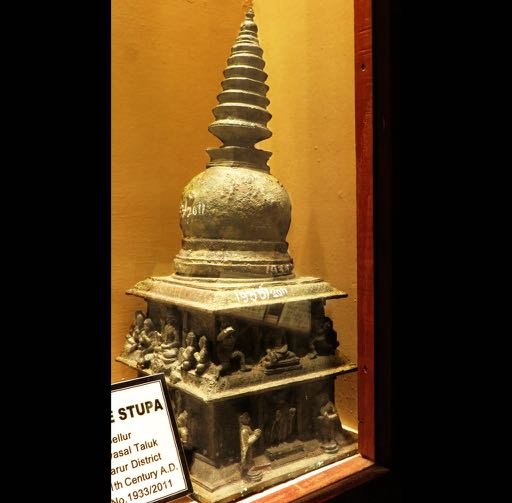
The upper depiction of this side (Side 4, Picture N) is about the Buddha’s victory over the Maras and attaining enlightenment at Bodhgaya. The Buddha is seated with left-hand in dhyana-mudra and right hand in bhumi-sparsha-mudra (gesture of touching the earth and declaring that the earth is the witness). Maras are standing on both sides to attack the Buddha. This depicts the night of enlightenment when the Buddha conquered the Maras (the demons of afflictive emotions) attained enlightenment and became Arhat-Samyak-Sambuddha.
The lower depiction is about the Buddha performing miraculous deeds at Shravasti as a display of his realization when challenged by tirthikas. The Buddha is seen standing with the left hand in karana-mudra (gesture of warding off obstacles and negativities) and right hand in abhaya-mudra (gesture of protection). Two disciples are standing on both sides with anjali-mudra.
Bodhisattva Statues from Sellur
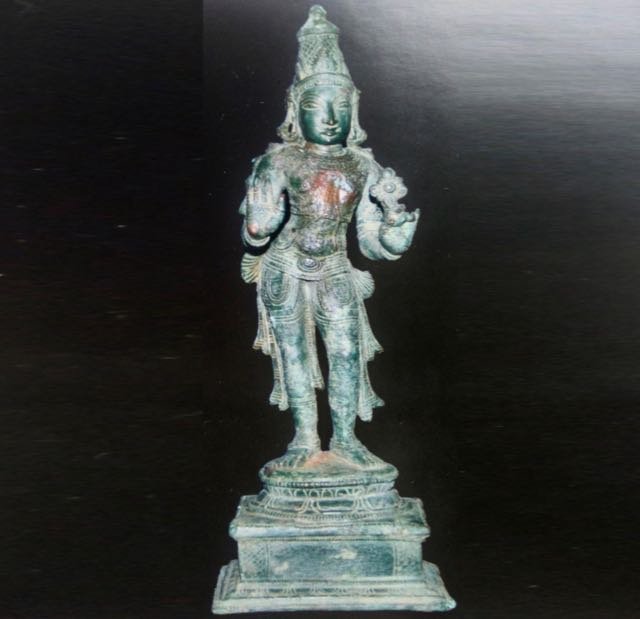
This ancient bronze statue of Maitreya (8 inches) is probably in reserve. Bodhisattva has a naga-flower on the left hand. The right hand is in abhaya-mudra (the gesture of giving protection). He has a kirita-makuta (jeweled crown) with a stupa engraved on it.
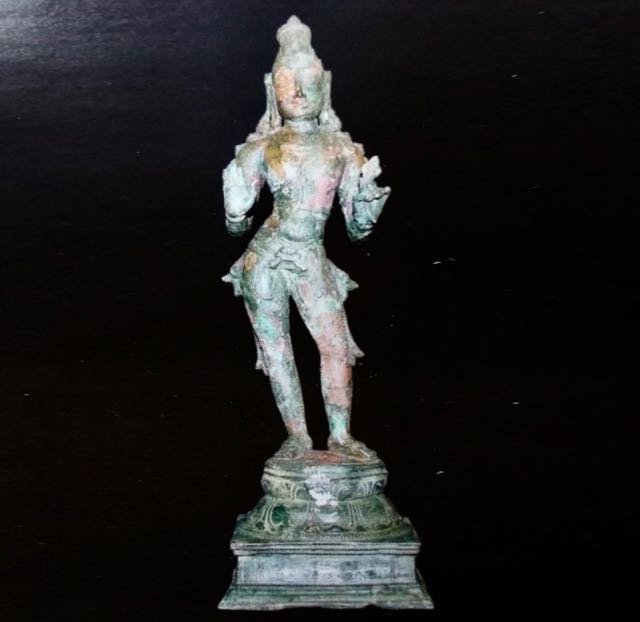
This bronze statue of a Bodhisattva (probably in reserve) is, according to the archeologists, that of Bodhisattva Maitreya. They identify so based on an unclear engraving of a stupa upon his kirita-makuta (jeweled crown). However, from the photo, it appears that he is holding a lotus flower and not a naga-flower-bunch. So, he might as well be Avalokitesvara. (This statue is probably in reserve)
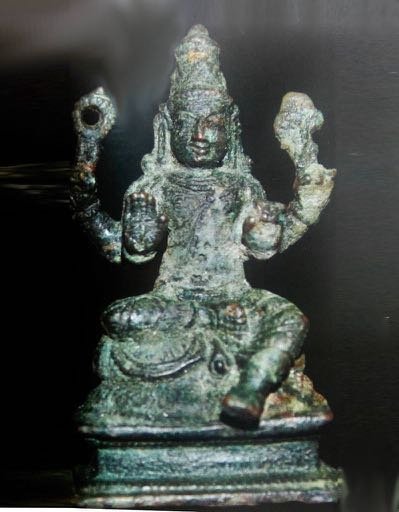
This miniature bronze statue is identified by archeologists as Avalokitesvara, maybe because there is no stupa on the crown and may be because of four hands. However, since the flowers resemble a bunch of Naga pushpas than lotus, this might be Maitreya. His upper right-hand holds a mala (rosary). The other two hands are in abhaya (gesture of giving protection) and karana (gesture of warding off obstacles and negativities) mudras. It is (This statue is probably in reserve).

The above miniature statue (‘R’) is made of stone. Archeologists identify this to be Bodhisattva Avalokitesvara in similar lines as picture ‘Q’. However, here again, since the flowers resemble a bunch of Naga pushpas than lotus, this might be Maitreya. (Thi statue is probably in reserve).
Bhikshu Statue from Sellur
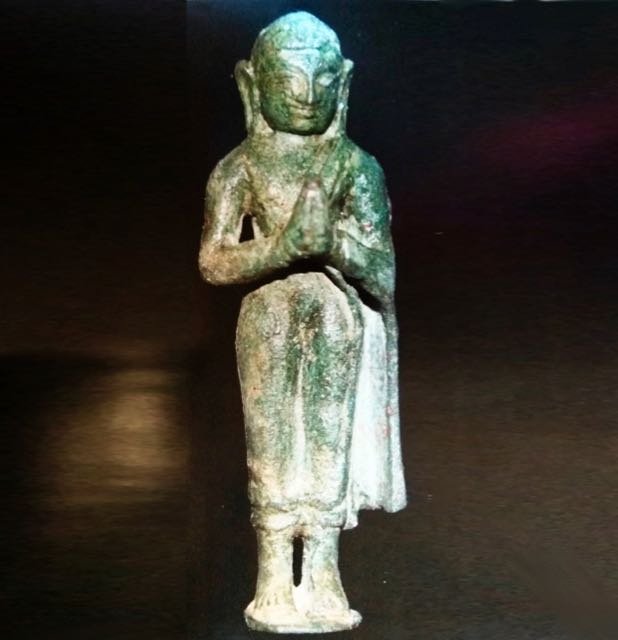
This miniature bronze statue of a Bhikshu (3 inches) is similar to the Nagapattinam collection. (This is probably in reserve.)
References

Other Posts Related to Thiruvarur and Nagapattinam:
Poompuhar – A Long Lost City from the Sangam Age
Nagapattinam – The last citadel of Buddhism in South India
Ancient Buddhist statues unearthed in Sellur, Tamil Nadu
Buddhism in Thiruvarur, Tamil Nadu
A Majestic Vestige of Buddhism in Pushpavanam
Buddha Statues of Buddhamangalam and Peruncheri.
- Putheri (Buddheri) – The Southern most Stupa of Ancient India - January 19, 2023
- History of Buddhism in Kerala - January 12, 2022
- Buddhism in Kallakurichi, Tamil Nadu - March 4, 2021


